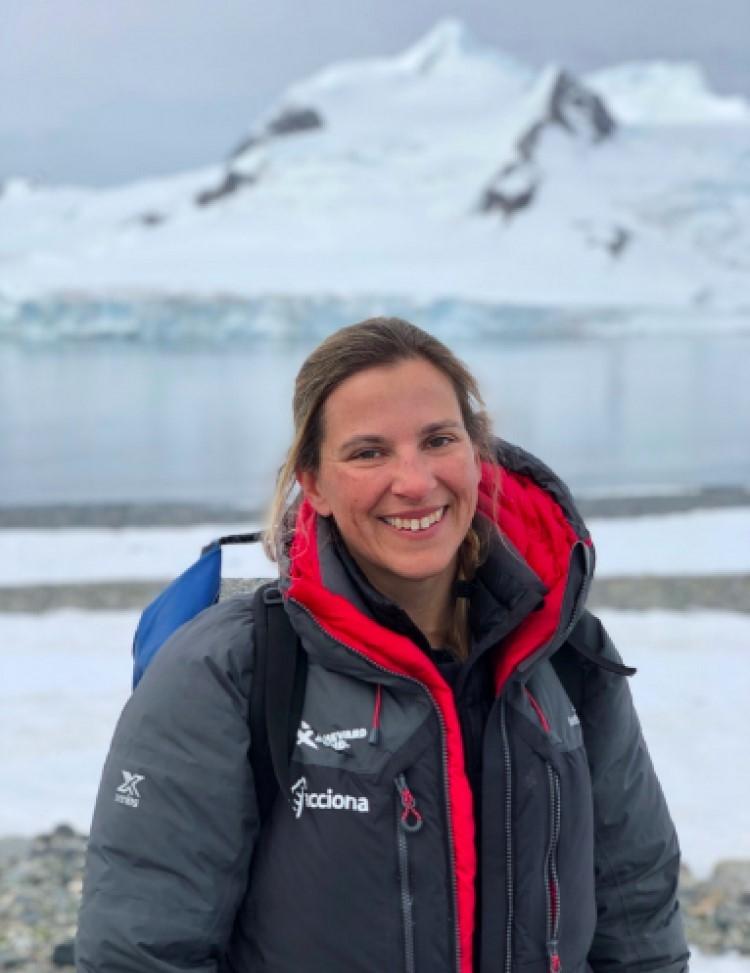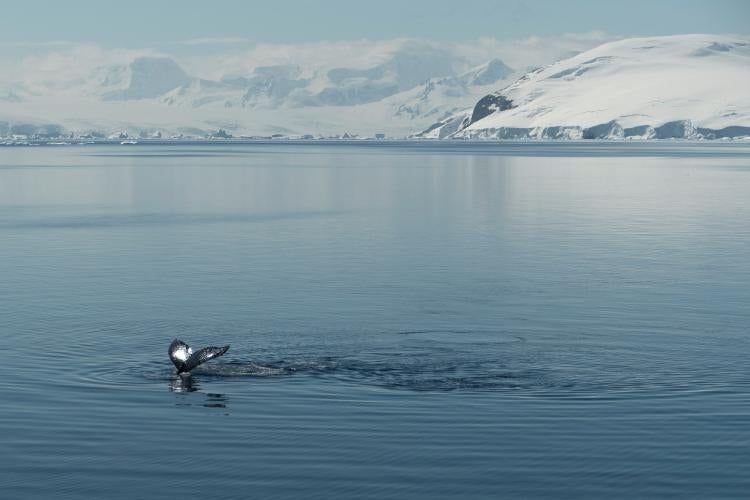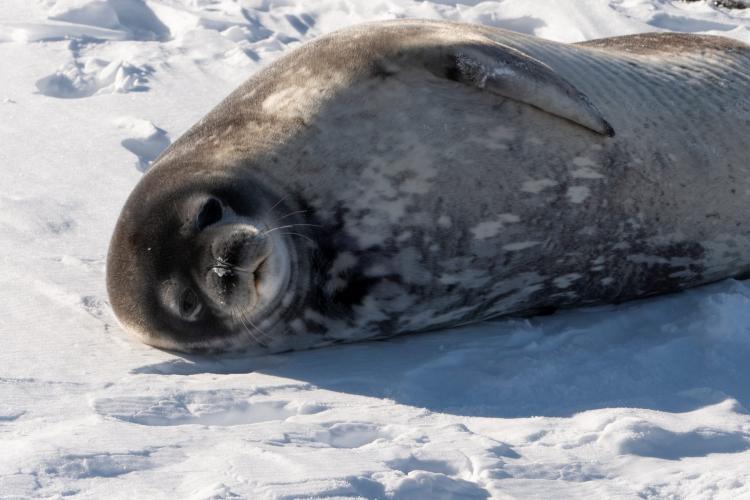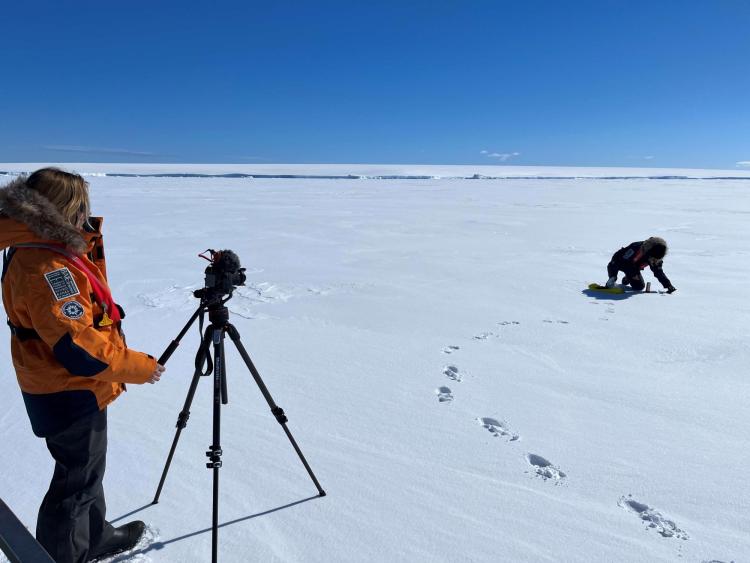Cassandra Brooks, whom The Explorers Club has honored as an ‘extraordinary person’ doing ‘remarkable work to promote science and exploration,’ gives onsite lessons on the ‘vital’ ecosystem
When she is in Antarctica, Cassandra Brooks normally works to expand the frontiers of human knowledge. This month, she returned from a trip not focused on scientific research but on expanding the horizons of eco-tourists.
In January, Brooks, assistant professor of environmental studies at the University of Colorado Boulder, joined a half-circumpolar expedition led by small ship cruise line Ponant in collaboration with The Explorers Club, a multidisciplinary scientific professional society, and open to the public. On the expedition, Brooks was the featured speaker.
The expeditioners were on the Commandant Charcot, a cruise ship operated by Ponant. The trip’s promotional material noted that Ptolemy, the Alexandrian mathematician, astronomer and geographer, argued that there must be a southern land mass to balance out the continents of the north.

CU Boulder researcher Cassandra Brooks recently was a featured speaker on a half-circumpolar expedition led by small ship cruise line Ponant in collaboration with The Explorers Club.
Brooks likes the metaphor: “There’s a lot of truth to the idea that the world will topple over were it not for the weight of Antarctica,” she told Ponant. “Its ecosystem in general—and the ecosystem of the Southern Ocean in particular—are vital to the world’s survival.”
In 2022, The Explorers Club recognized Brooks as one of “50 extraordinary people who do remarkable work to promote science and exploration but remain under the radar and out of the limelight.”
She was as a core member of The Last Ocean, a grand-scale media project focused on protecting the Ross Sea. Her work helped drive the adoption of the world’s largest marine protected area in the Ross Sea, Antarctica, one of the healthiest marine ecosystems left on Earth.
Brooks, who is also a faculty fellow at the CU Boulder Institute of Arctic and Alpine Research, recently answered questions from Colorado Arts and Sciences Magazine about her trip. The Q&A follows:
Question: You’ve delivered presentations previously, of course, but your half-circumpolar expedition with the Explorers Club stands out. What were your hopes and expectations as a presenter and scientist for this trip?
Brooks: The Explorers Club was founded in 1904 and traditionally celebrated exploration in the form of pushing physical frontiers, like being the first to reach the South Pole or climb Mount Everest. The Explorers Club has evolved to also celebrate exploration in the form of scientific discovery, and nowadays, exploration in the form of storytelling, conservation, protection and more.
In 2022, for my work in Antarctic conservation, I received their Explorers Club 50 honor, being recognized as one of the 50 people changing the world that the world needs to know about. It’s been an amazing experience and honor to be welcomed into this community in this new era of exploration!
While on board the Commandant Charcot with The Explorers Club for their new partnership with Ponant, I worked to educate and inspire. While the participants were intimately experiencing Antarctica, and no doubt falling in love with its austere beauty, I was sharing with them the importance of Antarctica to the world, how it is threatened by climate change and other human uses, and how we can work together to protect it.
I shared the story of how the global community came together in 2016 to protect the Ross Sea, Antarctica. We visited the Ross Sea at the end of our journey, a region that is now the world’s largest marine protected area. I shared the fascinating details of how life has evolved in Antarctica, developing remarkable adaptations, such as animals having anti-freeze in their bodies.
There is even a special family of fish called ‘Icefish’ that have no hemoglobin, only white-blood cells. In the oxygen rich Southern Ocean, these fish adsorb oxygen directly through their skin. Brooks lab PhD candidate Zephyr Sylvester also joined the expedition, and she shared stories of Antarctic krill, the small crustacean which feeds the extensive populations of birds and mammals that inhabit the Southern Ocean.

A humback whale swims in Hanusee Bay in Antarctica. (Photo: Cassandra Brooks)
In the spirit of The Explorers Club, we celebrated Antarctica for its history of exploration, for the scientific discoveries of the past, present and future, and for its remarkable conservation value. Throughout the expedition, participants engaged in exploration: Exploration through navigating waters few have navigated before. Exploration through knowledge generation and scientific discovery as Ponant had a scientific team on board.
We also engaged in exploration through storytelling. Given the incredible and urgent threats to Antarctic life, now is also the time for exploration for conservation. After experiencing this remote, austere, beautiful seascape, which teems with life superbly adapted to the cold, our hope is that we were able to help inspire participants to leave the expedition motivated to help protect Antarctica.
Question: You’ve visited Antarctica as a researcher, but this time you went as an expert presenter for a select audience. How did this trip differ from a “normal” expedition for you?
Brooks: This trip was anything but normal for me! I admit that I longed to be engaging in research while on board, and while that was not possible, I so appreciated being able to teach the participants about Antarctica, to deepen their understanding of this amazing place and to share my passion for protecting it.
I learned a lot, too, about the ways in which tourist vessels can be platforms for scientific research and how careful tourist operators are about ensuring they do not harm Antarctica and its wildlife. We also traveled to places many research vessels don’t frequent, including stretches of the icy Bellingshausen and Amundsen Seas.
For me, this was my first time visiting these parts of Antarctica, and I was absolutely struck by their unique beauty and life. We saw the rare and mysterious Ross Seal, another first for me. All of us on board and surely bonded for life after sharing this profound experience together.
Question: You hold a graduate certificate in science communication. In this time of polarized discussion about climate science and a range of other scientific topics, are there strategies that you employ to maximize the effectiveness or persuasiveness of your communications?
Brooks: Effective science communication demands good storytelling and connecting with people. I find that bombarding people with facts, including about climate change, is not necessarily persuasive or even informative if it’s not delivered in a way that will stick in their hearts and minds.

A Weddell seal in Antarctica's Cape Evans. (Photo: Cassandra Brooks)
During my talks, I try to tell stories, for example, reminding people that even before the continent of Antarctica was discovered, the ancient Greeks insisted that a great southern land must exist, in symmetry with the land mass in the north. Without it, they said that the world would topple over.
We now know that the Greeks were right, because since the discovery of Antarctica, scientists have revealed that it stores the majority of the world’s freshwater, regulates our climate and drives global circulation. As the Greeks said, the great southern land keeps the world in balance and even stores disproportionate amounts of heat and carbon, especially buffering us from the impacts of climate change.
We have beautiful figures using the Spilhaus projection showing Antarctica rightly placed at the center of the map, demonstrating its role in the Earth system. I also share why protecting Antarctica has become so personal for me. I used to make a call to protect Antarctica so that my children, including my daughter Adelie (named for the Adelie penguin) and my son Orion Ross (named for the Ross Sea), could grow up with a Southern Ocean thriving with life.
And while protecting Antarctica for the sake of its wildlife is still incredibly important to me, the reasons have become more visceral. I’ll never forget the day in the middle of 2020 when I took my kids hiking on one of our favorite trails. The late day summer sun, and the Rocky Mountains of Colorado were behind me, when suddenly the sky went dark.
I turned to see a massive black cloud of smoke expanding out and blotting out the sun, and immediately a cloud of thick ash was raining down on us. The smoke continued for almost four months straight, with conditions so toxic, we had to stay locked indoors as the expansive forests of Colorado burned.
The next year, almost 1,000 houses burned within kilometers of ours, another record fire, this time in heart of winter. Now the fires continue with no end in sight. Even my childhood home in the northeastern United States was plagued by smoke last summer; there is nowhere to go. Nowadays, almost everyone has similar stories, and if not of fire, then of other extreme events.
And, of course, the world is burning. It’s warming, dramatically. The early days of June saw us breach the 1.5C warming threshold with predictions from the World Meteorological Organization that we are likely to exceed the 1.5C threshold for at least one year within the next four years.

Cassandra Brooks (left) films Ulyana Horodyskyj Peña on a recent expedition to Antarctica. (Photo: Cassandra Brooks)
But it is not hopeless. While the (Intergovernmental Panel on Climate Change) reports call for urgent climate action, they also still suggest (that with immediate reductions in greenhouse gases) that we can secure a livable future. Antarctica is core to that future. Through doing more to safeguard Antarctica, we actually stand to create a more livable world for us all.
Question: Also on board the ship with you was Ulyana Horodyskyj Peña. Can you describe her role and how it buttresses or complements yours?
Brooks: On the Commandant Charcot, Ponant provides a platform for scientific exploration. Explorers Club member Ulyana Horodyskyj Peña joined the expedition to sample snow looking for black carbon, evidence of our human impact even in this most unexplored region. She also collected water samples to look for microplastics.
She’ll be analyzing her samples when she returns to CU Boulder. While her role was a scientist on board, she also gave talks to the participants, teaching them about how black carbon exacerbates warming and the melting of ice.
During the trip, Ulyana and I worked together to capture captivating imagery and video, including of the exploration and science being conducted aboard the Commandant Charcot. In the spirit of The Explorers Club, we sought to provide exploration through media and storytelling, capturing the beauty of this place, sharing imagery from this last intact wilderness with the world.
Question: For those of us who are unlikely to travel to Antarctica, could you share something memorable or unique about being there?
Brooks: Antarctica is so profoundly beautiful and awe-inspiring. Being there is a visceral experience that is all encompassing. Every moment takes your breath away. It is not only visually beautiful, but there is also something about the grand scale of the place:
The towering icebergs. Ice that spans in all directions seemingly into infinity. Life in the form of penguins, seals and whales popping out in the most unimaginable places all along the ice edges and cracks. The biting cold and wind, the mighty swells and salt sprays of the dark Southern Ocean make you feel alive and absolutely connected to the Earth, out of which all our lives arise.
Top image: (left to right) Cassandra Brooks, Ulyana Horodyskyj Peña and Zephyr Sylvester in Antarctica's Bay of Whales (Photo: Cassandra Brooks)
Did you enjoy this article? Subcribe to our newsletter. Passionate about environmental studies? Show your support.



